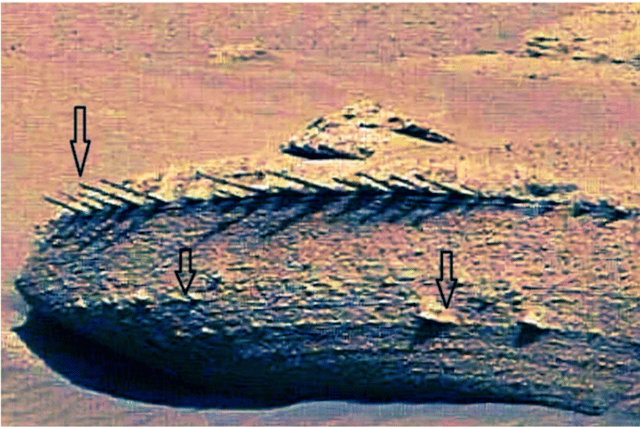Scientists cannot rule out alien spaceship 'crashed-landed on Mars' after pointy objects were found on surface
and live on Freeview channel 276
Scientists cannot rule out that the strange pointy protrusions found on the surface of Mars are the result of an extraterrestrial spacecraft crash landing on the planet.
NASA's Curiosity rover photographed what appears to be rows of spikes, plates ad wedges on the red planet's surface, back in April.
Advertisement
Hide AdAdvertisement
Hide AdThe pattern was on the floor of the 96-mile (154 km) Gale Crater. Astrobiologist Dr Nathalie Cabrol, of the NASA Ames Research Centre and Search for Extraterrestrial Intelligence (Seti) Institute, said it was “the most bizarre rock” she had ever seen in 20 years of studying Mars.


A new paper published in the Journal of Astrobiology states that the marks could be from "sand spikes", which are similar to those formed on Earth in water-logged sands during strong earthquakes.
However, researchers of the paper say that “a fragment from an extraterrestrial or terrestrial spacecraft cannot be discounted with absolute certainty”.
Wheels, an axle and a debris field have been photographed in another part of the crater. But a small debris field connected to the spikes may have been eroded over time.
Advertisement
Hide AdAdvertisement
Hide AdProfessor Richard Armstrong, of Aston University, Birmingham, who is the first author of the paper, told The Telegraph: “There is no way of proving for certain what the spikes are but the balance of the evidence would suggest ‘sand spikes’ resulting from seismic activity on Mars.
“I suspect the enigmatic ‘wheels’ are a separate phenomenon. Mars images often show strange formations and features which ‘look like’ familiar objects.”
But he added: “Any debris field on Mars would certainly suffer erosion over time, especially from wind.”
The picture shows at least six rocks with strange protrusions, which includes one with 11 evenly spaced spikes.
Advertisement
Hide AdAdvertisement
Hide AdWedge-shaped objects resembling shark teeth can also be seen below the spikes, as well as plates or boards that appear to have embedded spikes.
In the journal, the authors have suggested that the equipment may be from a previously crashed Mars orbiter or discarded equipment. However, the authors of the paper say that the equipment does not look like anything from Earth.
“Given that possibly 10 or more craft have crashed upon the surface, coupled with the jettison of equipment associated with landing the rovers, it is possible the spikes and its substrate are human-made and consist of debris that fell onto the surface of Gale Crater. Nevertheless, no debris field is evident and no evidence of any additional debris that may have originated on Earth."
“Given its small size and that there are no known human-made analogues and no logical explanation as to what purpose these spikes may serve, it does not seem likely these specimens are the remnants of craft or equipment that fell into Gale Crater. One can only speculate about extraterrestrial origins," they added.
Advertisement
Hide AdAdvertisement
Hide AdOther explanations given by the experts are that the spikes could be linked to activity by tiny microorganisms on the planet because they are close to features reminiscent of fungi or microbialites – which are layered rocky structures formed by communities of microbes.
They may also be the remains of petrified algae or trace fossils, such as sand-filled worm burrows.
Comment Guidelines
National World encourages reader discussion on our stories. User feedback, insights and back-and-forth exchanges add a rich layer of context to reporting. Please review our Community Guidelines before commenting.
